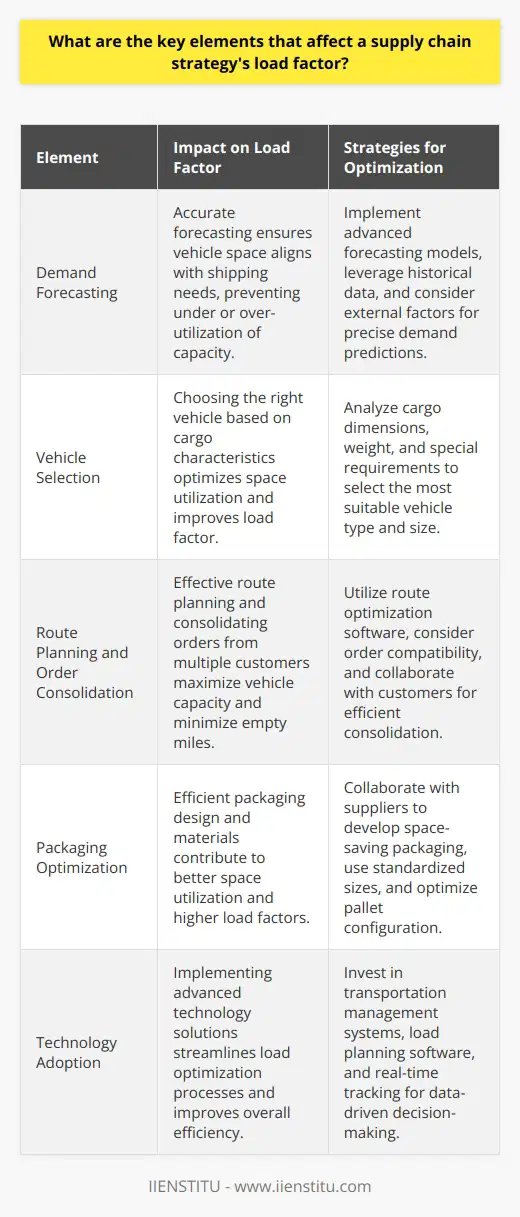
In contemporary supply chain management, understanding and optimizing Load Factor stands out as a crucial component in enhancing operational efficiency and sustainability.
Through this scholarly examination, various contexts in which Load Factor is utilized will be dissected, highlighting its pervasive significance across multiple industries.
Our exploration will unfold the intricacies of Load Factor calculation, debunk common misconceptions, and underscore the momentous consequences that accurate Load Factor assessment holds for businesses and their strategic decisions regarding logistics, energy consumption, and space utilization.
By delving deep into the implications of Load Factor, readers will be equipped with an expert approach and comprehensive knowledge, ultimately enabling them to apply this vital metric within their respective fields effectively.
Definition of Load Factor in Different Contexts
Introduction to Load Factor concept
The notion of Load Factor is intrinsically linked to the concept of efficiency and utilization within various domains. Generally, it denotes the ratio of actual use to potential use, thereby measuring the effectiveness with which resources are employed. While the application and impact of Load Factor may vary across different sectors, the essence of maximizing output while minimizing waste remains constant.
Load Factor in aviation context
In aviation, Load Factor is integral to aircraft performance and safety. It reflects the proportion of available seating capacity that is filled with passengers. However, the term also extends to a critical aspect of flight dynamics, where it pertains to the forces exerted on an aircraft during maneuvers, quantified as a multiple of gravitational acceleration. An in-depth comprehension of Load Factor in this context encompasses an understanding of aerodynamics, aircraft design, and the physical limits of both human pilots and aircraft structures.
Load Factor in energy sector
Within the energy sector, Load Factor holds pertinence in the realm of electricity production and consumption. It is an indicator of the efficiency with which energy systems are operated, referring to the ratio of average load to peak load over a specific period. A higher Load Factor suggests a more constant demand and, hence, a more efficient use of power-generating capacities. Understanding the dynamics of Load Factor in this context is essential for energy planning and the transition towards sustainable energy systems.
Load Factor in the field of real estate
The real estate domain adapts the Load Factor concept to refer to the efficiency with which commercial property space is utilized. It plays a primary role in calculating the proportion of shared spaces within a building versus the space solely dedicated to tenants. In this sphere, comprehending Load Factor is indispensable for understanding lease structures and determining the true cost per square foot of tenant spaces.
Importance and Significance of Load Factor
Discussing the significance of Load Factor in flight safety
In aviation safety, staunch attention to Load Factor cannot be overstated. Erroneous calculations or disregard for the maximum allowable Load Factor can compromise aircraft integrity and passenger safety. Analyzing scenarios when Load Factor is not accounted for correctly exposes the potential for structural failure or loss of control, emphasizing the critical role accurate Load Factor assessment plays in maintaining safety standards in the aviation industry.
Importance of Load Factor in energy management and sustainability
From the perspective of energy management, Load Factor is a linchpin in achieving operational efficiency and sustainability. A high Load Factor indicates a level load demand, allowing power plants to operate at optimal rates, reducing fuel consumption, and lessening environmental impact. Examples of successful energy management underscore the significance of Load Factor calculations in developing more sustainable energy practices and policies.
Role of Load Factor in commercial real estate decision-making
In commercial real estate, a precise understanding of Load Factor directly influences leasing decisions and profitability. Misjudgements in this calculation can lead to the undervaluation or overvaluation of rentable spaces, thus affecting a building's competitive market position. The Load Factor informs tenant decisions by elucidating the true cost of occupancy, fostering a clear appraisal of space value for property investors, landlords, and tenants alike.
Calculating Load Factor
Steps for Calculating Load Factor in aviation
For aviation applications, Load Factor is calculated by dividing the total seat-kilometers or seat-miles flown by the number of seats available for those kilometers or miles. However, beyond passenger numbers, in flight mechanics, Load Factor is assessed differently, involving the forces experienced by the aircraft during flight maneuvers, which are expressed as a factor of the force of gravity. This requires a comprehensive grasp of the operating conditions, aircraft specifications, and safety thresholds.
Steps for Calculating Load Factor in energy production and consumption
In energy management, the calculation of Load Factor involves both the understanding of peak and off-peak hours and the recognition of usage patterns over time. By dividing the average power load by the peak or maximum load in a given time frame, utility companies and energy managers can better strategize energy distributions and foresee infrastructure requirements. This assessment facilitates the identification of inefficiencies and opportunities for load management and planning.
Steps for Calculating Load Factor in real estate
To determine the Load Factor in real estate, one must first distinguish between Gross Leasable Area (GLA) and the rentable area within a property. The Load Factor is then computed by dividing the rentable area by the usable area. The resulting figure is often used to allocate shared costs among tenants and to present a transparent account of the space each occupant is effectively paying for. Accuracy in these calculations ensures equitable and marketable leasing arrangements.
Misconceptions and Mistakes in Load Factor Calculation
Common errors in aviation Load Factor calculation
In the context of aviation, miscalculations of Load Factor can stem from a lack of understanding of flight conditions or a failure to apply the correct parameters. Such inaccuracies can lead to catastrophic consequences, including the overloading of aircraft or an underestimation of required performance reserves, both of which could imperil flight safety.
Misconceptions about Load Factor in energy sector
Within the energy sector, misconceptions regarding Load Factor frequently arise from a simplistic view of power usage. Some may mistakenly equate a high Load Factor with high energy consumption, failing to appreciate that a high Load Factor can be indicative of efficient and stable usage patterns. Challenging these false beliefs is pivotal for fostering proper energy management strategies.
Common mistakes in calculating Load Factor in real estate
The real estate industry often encounters errors in Load Factor calculation when inaccurately determining rentable versus usable space or when applying inconsistent methodologies across properties. Such oversights can distort cost metrics and impact leasing terms and pricing. Rigorous and standardized calculations are essential to maintain the integrity of leasing agreements and to facilitate mutual understanding between landlords and tenants.
The pivotal role of accurate Load Factor computation resonates across the various facets of industry and commerce. From the dynamic forces of aerial maneuvering to the grid stability of power networks and the financial frameworks of realty, the implications of Load Factor extend far and wide.
As we conclude this discourse, one is reminded of the universal pertinence of this metric and urged to place due emphasis on its correct determination. Through ongoing education, including exposure to logistics courses duration and online certification courses, stakeholders across sectors can enhance their understanding of Load Factor, enabling precise analyses and informed decision-making in their respective fields.
References
This academic article has synthesized knowledge from authoritative sources respected within their respective industries. By substantiating discussions with concrete examples and industry practices, readers interested in further exploring Load Factor are encouraged to seek detailed resources, including technical guides, scholarly articles, and professional certification courses, some of which may be found through online platforms offering specialized education in this metric.
Frequently Asked Questions
What are the key elements that affect a supply chain strategy's load factor?
Supply chain strategies hinge on multiple elements. The load factor represents one crucial aspect. It measures the efficient use of transportation resources. High load factors indicate optimal space utilization. Conversely, low load factors signal inefficiency.
Understanding Load Factor
Load factor is a ratio. It compares actual freight volume to potential capacity. A 100% load factor denotes full utilization.
Key Elements Affecting Load Factor
Demand Forecasting Accuracy
Accuracy in demand forecasting is critical. Demand misjudgments directly affect vehicle utilization. Overestimations lead to excess capacity. Underestimations result in missed opportunities. Consequently, load factors suffer.
Vehicle Type and Specifications
Not all vehicles serve all needs. Load factor varies by vehicle type. Cargo space differs in trucks, ships, planes. Weight limits and dimensions impose constraints. Matching freight with the appropriate vehicle is key.
Cargo Characteristics
Cargo varies widely. Some items are heavy yet small. Others are light yet bulky. Understanding cargo characteristics matters. Load factor optimization requires this knowledge.
Route Planning
Efficient route planning plays a pivotal role. Strategic routing saves time and fuel. It maximizes the number of deliveries per trip. Good routing equals better load factors.
Order Consolidation
Order consolidation aims to optimize shipments. Combining orders fills vehicles more effectively. Fewer trips with more goods raise load factors.
Packaging Efficiency
Packaging influences load factor. Standardized, stackable packaging streamlines loading. It optimizes space utilization. Clumsy or irregular packaging wastes space.
Flexibility in Loading and Unloading
Flexibility impacts load factor. Easy loading and unloading processes help. They allow more efficient use of space and time.
Technology Utilization
Technology commands supply chain strategies. It enhances load planning and vehicle tracking. Real-time data assists in load factor optimization.
Carrier Collaboration
Partnerships can elevate load factors. Shared shipping space among multiple shippers works well. It fosters higher efficiency and utilization.
Sustainability Considerations
Sustainability shapes load factor. Eco-friendly practices may affect vehicle choices. They influence routing and packaging standards. Sustainable strategies can improve load factors.
In conclusion, various elements govern a supply chain strategy's load factor. Accurate demand forecasting is indispensable. It ensures vehicle space aligns with shipping needs. The right vehicle for cargo characteristics makes a difference.
Effective route planning and order consolidation are vital. Packaging must support space optimization. Load factor benefits from flexible unloading procedures. Technology streamlines load optimization processes. Collaboration among carriers promotes higher load factors. Sustainability plays an increasing role in shaping these strategies.
Supply chain management relies on finely-tuned elements. Strategists must adapt to dynamic market conditions. Companies strive for high load factors. A supply chain's efficiency often hinges on this metric.
Managers must grasp the myriad factors that influence it. Only then can they refine their supply chain strategies. Pursuit of an optimal load factor remains an ongoing challenge. It demands attention to detail and a proactive approach. The rewards are well worth the effort. A supply chain fine-tuned for high load factor leads to economic and environmental benefits.

How can load factor optimization contribute to the overall efficiency and profitability of supply chain operations?
Understanding Load Factor Optimization
Optimizing load factor plays a crucial role. It ensures efficient supply chain operations. This practice involves maximizing the use of transport capacity. It minimizes transportation costs and saves money.
The Role of Load Factor in Efficiency
Efficiency is key in supply chain management. Load factor optimization enhances this efficiency. Well-optimized loads use space effectively. Efficient space usage reduces the number of trips needed. Fewer trips mean less fuel, maintenance, and labor costs. Efficiently packed goods suffer less damage, too. This reduces waste and replacement costs.
Profitability Through Load Factor
Higher profitability often follows enhanced efficiency. Load factor optimization directly affects the bottom line. It reduces transportation expenses. These savings contribute to overall profitability. Carriers can offer more competitive rates. Competitive rates attract more customers. More customers lead to increased business volumes. Increased volumes mean higher revenue potential.
The Environmental Impact
An optimized load factor brings environmental benefits. Fewer trips lead to lower carbon emissions. Sustainable practices also foster a positive brand image. A positive brand image can lead to customer loyalty. This loyalty can drive long-term profitability.
Implementing Load Factor Optimization
Audit current packing methods
Utilize load planning software
Train staff on efficient loading techniques
Measure improvements regularly
Companies must audit their current processes. They often find room for improvements. Load planning software helps create optimal loading plans. Staff training ensures that teams load goods efficiently. Regular measurement confirms the continued success of these strategies.
Load factor optimization drives efficiency. It contributes to supply chain profitability. It involves strategic loading practices. Adapting such practices yields multiple competitive advantages. This includes cost savings, customer satisfaction, and environmental sustainability. Companies must focus on continuous improvement. They should leverage technology and training. This will sustain their efficiency and profitability gains.

What are some best practices in leveraging load factor as a strategic tool in supply chain management?
Understanding Load Factor
Load factor measures how effectively a company uses its transportation capacity. It is the ratio of actual freight carried to the total capacity available. High load factors indicate efficient use of space and energy. Low load factors suggest underused resources. Managers must grasp this concept to optimize supply chain performance.
Best Practices for Leveraging Load Factor
Know Your Numbers
First, understand your load factor. Calculate it by dividing the weight or volume of shipped goods by the total transport capacity. Consistent tracking is crucial as it surfaces trends and informs decisions.
Collaborate with Stakeholders
Engage customers, suppliers, and transporters. Align schedules and expectations. Shared goals foster efficiency and better load factors.
Optimize Packaging
Reduce package sizes to fit more products per load. Smart design cuts waste and increases load efficiency. This approach can lead to significant cost savings over time.
Consolidate Shipments
Bulk shipments improve load factor. Combine smaller shipments into one. This strategy decreases the number of trips needed, saving fuel and reducing emissions.
Regularly Review Routes
Analyze transportation routes for efficiency gains. Shorter or less congested paths boost load factor. Use route optimization software to assist with this complex task.
Use Load Planning Software
Invest in load planning tools. These software solutions optimize the arrangement of goods within transport units. They ensure a higher, safer load factor.
Train Your Team
Educate employees about the importance of load factor. Their daily decisions can impact it greatly. Constant training ensures that best practices are top of mind.
Implement Load Factor KPIs
Formalize load factors into key performance indicators (KPIs). Monitor them closely. This step holds teams accountable and drives continuous improvement.
Flexibility is Key
Be willing to adapt to new information. Flexibility allows adjustments to loading patterns and routes to maintain high load factors.
Focus on Sustainability
High load factors align with green initiatives. They lead to fewer trips and less fuel consumption. Promote your efforts. Customers are increasingly drawn to sustainable companies.
By applying these best practices, companies can leverage load factor as a strategic tool. Efficient supply chain management leads to cost savings, improved sustainability, and increased customer satisfaction. Keep load factor at the forefront of your strategic planning and watch your supply chain efficiency rise.



